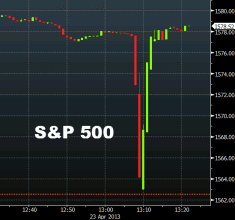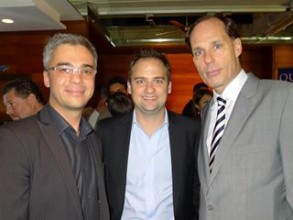The recent Hack Crash, where a fake news tweet from the account of Associated Press caused havoc on the financial markets, appears to be raising concerns about the pitfalls of social media and news-driven trading strategies within the finance industry.
The fake tweet, which was posted by someone that had hacked into Associated Press’ Twitter account, claimed that there had been an explosion at the White House and that President Obama had been injured. Because it appeared to be from such a credible news agency, the markets reacted instantly – and violently. The Dow Jones dropped by 145 points, wiping $136 billion off its value.
Social Media + HFT = Disaster?
Without a doubt, the massive over-reaction to the fake tweet was exaggerated by the effects of high-frequency trading robots, sent en masse into a feedback loop. It is not yet clear how much of this was merely a reaction to the rapid drop in price data, and how much was caused by the direct relationship between social media sentiment and automated trading systems. Some investment firms have been mining social media sentiment, using services such as Datasift and DataMinr, in order to inform their manual and automated trading strategies, and it is possible that this could have exacerbated, or even triggered, the market meltdown.
It is common for traders to keep an eye on Twitter alongside newsfeeds from mainstream business media outlets such as Reuters and Dow Jones, so it may have been a combination of manual and automatic traders reacting to the same instantaneous event that triggered the crash.
Quants Express Their Concerns
The day after the fake tweet rocked the markets, a gathering of quantitative investing specialists met for the ‘Battle of Quants’ conference in Manhattan. Having already planned an afternoon discussion called “Sentiment Analysis: Social Media and Big Data Analytics and Price Movement Predictability”, the so-called Hack Crash naturally dominated the agenda.
Zeid Barakat, co-founder of trading firm called Flyberry Capital that uses high-speed trading techniques to trade the news on commodity futures, was on the panel for these discussions. His firm mines data from hundreds of sources, from news wires to earthquake reports, to look for patterns that seem to produce viable trading conditions for certain types of short-term trade. While social media is part of the mix, it is distinctly secondary to the other data streams, although Mr Barakat says that his company might consider including some corporate Twitter feeds into its models in the future.
“The accuracy of tweets is a major concern,” he said. “Clearly what we had was an anomalous tweet; we didn’t trade because we didn’t have the depth of data to feel comfortable modeling a trade”
Social Media Entering the Financial Mainstream
Although the crash may have undermined the credibility of Twitter as a news source, it only served to confirm how influential it now is in the financial markets. While you might have been misled by the hoax tweet, if you weren’t following Twitter at all, you wouldn’t have known why the market was moving.
 Despite concerns over the reliability of tweets in comparison with other forms of data, they are increasingly being accepted into the mainstream. Last month, Bloomberg announced that it would be incorporating some Twitter accounts into its data service for the first time, and the SEC has given the go-ahead for corporations to disclose earnings news through social media outlets such as Twitter and Facebook. This has prompted concerns that the markets are becoming increasingly vulnerable to abuse via social media.
Despite concerns over the reliability of tweets in comparison with other forms of data, they are increasingly being accepted into the mainstream. Last month, Bloomberg announced that it would be incorporating some Twitter accounts into its data service for the first time, and the SEC has given the go-ahead for corporations to disclose earnings news through social media outlets such as Twitter and Facebook. This has prompted concerns that the markets are becoming increasingly vulnerable to abuse via social media.
The SEC’s decision to allow corporate earnings to be disclosed on social media was prompted by a Facebook post from Netflix CEO Reed Hastings announcing that the service was now exceeding a billion hours of streamed video per month. This announcement sent the price of Netflix shares soaring, alerting regulators to the power of social media on the markets, and its relevance to investors. “We appreciate the value and prevalence of social media channels in contemporary market communications, and the commission supports companies seeking new ways to communicate,” said the SEC in a statement on April 2.
The CFTC Wades In
If one 140-character message can send the markets into a (temporary) tailspin, could social media destabilise the entire global economy?
It is precisely this concern that led to a meeting between the Commodity Futures Trading Commission (CFTC) and 24 high-frequency traders in Washington last month to discuss potential safeguards against the effects of social media on the markets.
“In 2010, we passed Dodd-Frank, the big financial reform bill, but nowhere in there do they mention high-speed trading or technology,” said the CFTC’s Bart Chilton. “That’s how quickly markets are morphing. Now, here we are three years later, woefully unprepared.”
Tradersdna is a leading digital and social media platform for traders and investors. Tradersdna offers premiere resources for trading and investing education, digital resources for personal finance, market analysis and free trading guides. More about TradersDNA Features: What Does It Take to Become an Aggressive Trader? | Everything You Need to Know About White Label Trading Software | Advantages of Automated Forex Trading






































